英语国家概括串讲
- 格式:docx
- 大小:14.58 KB
- 文档页数:2
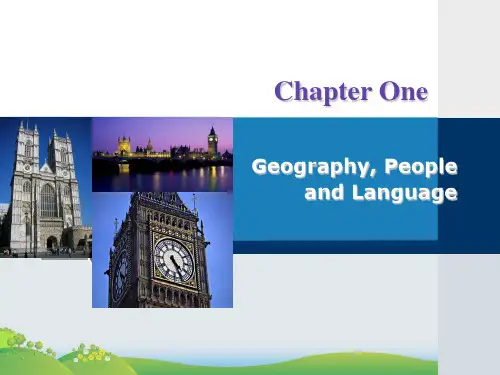
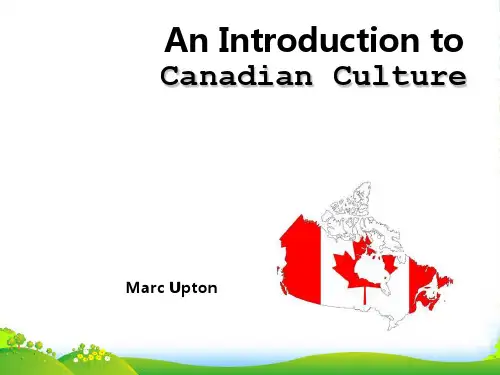

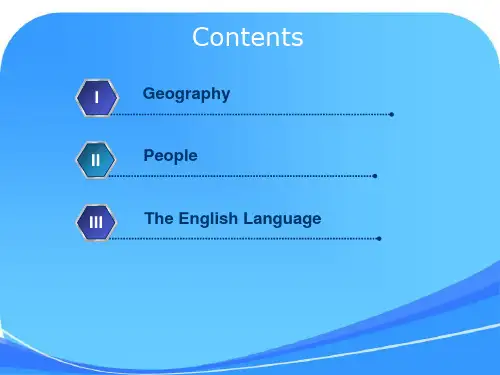


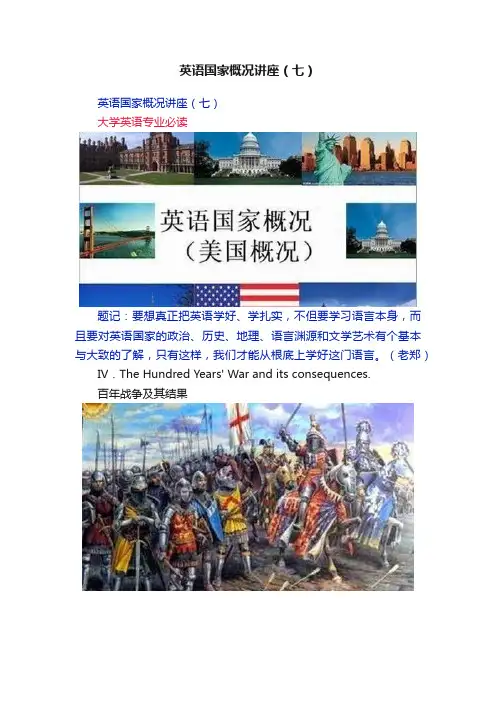
英语国家概况讲座(七)英语国家概况讲座(七)大学英语专业必读题记:要想真正把英语学好、学扎实,不但要学习语言本身,而且要对英语国家的政治、历史、地理、语言渊源和文学艺术有个基本与大致的了解,只有这样,我们才能从根底上学好这门语言。
(老郑)IV.The Hundred Years' War and its consequences.百年战争及其结果The Hundred Years’ War refers to the war between England and France that lasted intermittently from 1337 to 1453. The causes of the war were partly territorial and partly economic. The territorial causes were related with the possession by the English kings of the large duchy in France, while the French kings coveted this large slice. The economic causes were connected with cloth manufacturing towns in Flanders, which were the importer of English wool, but they were loyal to the French king politically. Besides, England's desire to stop France from giving aid to Scots and a growing sense of nationalism were the other causes.The English's being driven out of France is regarded as a blessing for both countries. If the English had remained in France, the superior size and wealth of France would have hindered the development of a separate English national identity, while France was hindered so long as a foreign power occupied so much French territory.百年战争指1337年到1453年英法之间一场断断续续的战争,战争的起因既有领土因素又有经济因素。
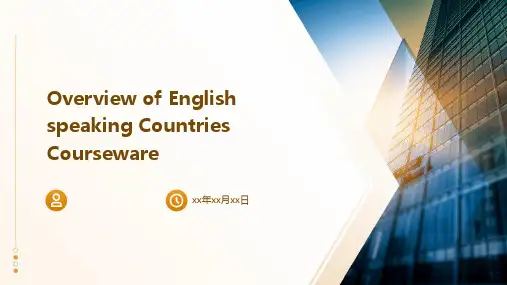
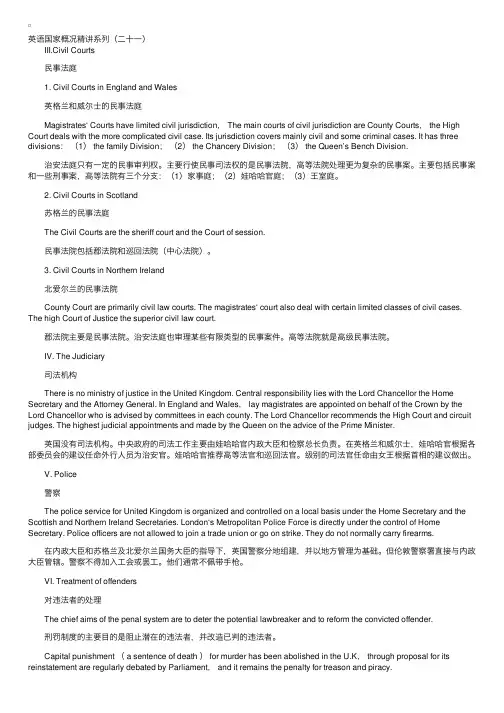
英语国家概况精讲系列(⼆⼗⼀) III.Civil Courts 民事法庭 1. Civil Courts in England and Wales 英格兰和威尔⼠的民事法庭 Magistrates‘ Courts have limited civil jurisdiction, The main courts of civil jurisdiction are County Courts, the High Court deals with the more complicated civil case. Its jurisdiction covers mainly civil and some criminal cases. It has three divisions:(1) the family Division;(2) the Chancery Division;(3) the Queen’s Bench Division. 治安法庭只有⼀定的民事审判权。
主要⾏使民事司法权的是民事法院,⾼等法院处理更为复杂的民事案。
主要包括民事案和⼀些刑事案,⾼等法院有三个分⽀:(1)家事庭;(2)娃哈哈官庭;(3)王室庭。
2. Civil Courts in Scotland 苏格兰的民事法庭 The Civil Courts are the sheriff court and the Court of session. 民事法院包括郡法院和巡回法院(中⼼法院)。
3. Civil Courts in Northern Ireland 北爱尔兰的民事法院 County Court are primarily civil law courts. The magistrates‘ court also deal with certain limited classes of civil cases. The high Court of Justice the superior civil law court. 郡法院主要是民事法院。
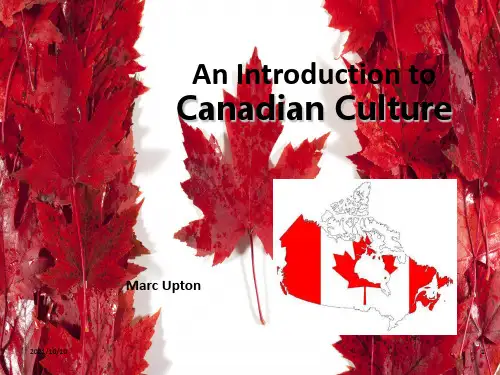
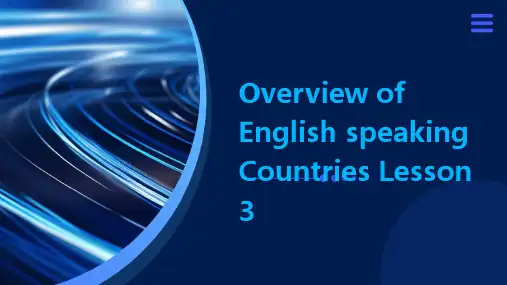
美国chapter 13geography 地理位置 1.Alaska and Hawaii are the two newest states inAmerican.Alaska northwestern Canada,and Hawaii lies in the central Pacific. 阿拉斯加和夏威夷是最近加入美国的两个新州。
阿拉斯加在加拿大的西北部,夏威夷位邻中太平洋。
(本细节还有考“一句话简答”的可能)2。
The U.S has a land area of 9.3 million square kilometres.It is the fourth largest country in the world in size after Russia,Canada and China. 就面积而言,美国是世界第四大国,就人口而言,美国是世界是第三大国。
3.Of all states of American, Alaska is the lagest in area and Rhode Island the smallest. But on the mainland Texas is the largest sate of the country. 所有州中,阿拉斯加是面积最大的州,罗得岛最小,在美国大陆,最大的州是得克萨斯州。
4。
The Rockies,the backbone of the North American Continent,is also known as the Continental Divide. 落基山脉是北美大陆的脊梁,也被成为大陆分水岭。
5 The two main mountain ranges in American are the Appalachian mountains and the Rocky mountains. The Appalachians run slightly from the northeast to southwest and the Rocky mountains run slightly from the northwest to southeast. 阿巴拉契亚山脉和落基山脉是美国的两座大山脉。
英语国家国情与文化考前串讲与复习大纲I.国情I考试题型与样题讲解II.国情I复习重点III.国情II考试题型与样题讲解IV.国情II复习重点I.国情I考试题型与样题讲解Section I Discourse Manipulation [20 points]Part 1. Question 1. (10 points)In the box below, five sentences of one paragraph have been put into random order. Reorganize these sentences to form a logically ordered paragraph. Write your answers on the Answer Sheet.Part 2. Question 2. (10 points)The following five paragraphs have been put into random order. Please put them into their logical order. Write your answers on the Answer Sheet. The first one has been done for you.A.The origins of most sports can easily be traced to the demands of warfare. This is seen most clearly in sports that involve fighting or throwing things, or teams attacking each others‟ territories. It also explains why sports have traditi onally been masculine affairs. And even though sport has become much more gender-equal in terms of facilities, it is still rare for there to be official competition between the sexes.B.The most popular pastime in Britain is the same as anywhere else: watching television. The next most popular is probably going to the pub. However, this does not mean that the British are a nation of lazy drunkards. Perhaps to make up for those unhealthy habits, two-thirds of all adults play some kind of sport.C. A third major influence on the shape of modern sports has been pressure from industry. Factories require their workers to be available at set times for work. They cannot work efficiently if half the work-force decides to go hunting for a couple of days. And so, in the 19th century in Britain, sports were codified in order to make them more regular and time-efficient so that the workers could get back to work on time.D.Britain was at the forefront of this codification because of the Industrial Revolution.This important process first started in Britain, and it is for that reason that Britain was the first country to organize sports along industrial lines. We can conclude that Britain did not invent the sports that the rest of the world now plays, but she was the first to organize them properly, and this is the legacy she has bequeathed to the world.E.Another influence on sport has been the seasonal requirements of agriculture. Agrarian communities typically play sports when the farming season is least busy. After harvest is such a time, for example, and in Britain it is easy to divide sports intoSection II Awareness of Course Content [40 points]Part 1. Questions 3 – 12. (20 points)Decide whether the following statements are true or false according to your understanding of the tutorial texts. Write T for “true” and F for “false” on the Answer Sheet._____3.The other mother-tongue languages in Britain are all dialects of English. _____4.Wales has replaced its traditional industries with the help of foreign investment._____5.The Protestants were in Ireland before the Catholics._____6.The tripartite system refers to the three types of secondary education made available by the 1944 Education Act._____7.China has 50% more students in higher education than the UK._____8.Elizabeth I was the Queen of Britain but Elizabeth II is the Queen of England._____9.Britain has never done particularly well in the Olympic Games._____10.The only mountains in Britain are in Wales and Scotland._____11.England has more than four-fifths of the total population._____12.The amusing thing about Arthur is that he wasn‟t English.3. F4.T5. F6.T7.T8. F 9. F 10.F 11.T 12.TPart 2. Questions 13 – 22. (20 points)Fill in each blank in the following passage with one word given in the box. Use capitals where necessary. Write corresponding letters on the Answer Sheet.The post-war __________(13) to Britain were looking for opportunities for work and __________(14). Many of them came from the __________(15) sub-continent. Pakistanis often bought little corner-shops as __________(16) businesses, which explains …paki-shop‟ as a new term for …corner-shop‟, although this is a poli tically __________(17) term.__________(18) were opened up by Chinese and Indian immigrants. They were __________(19) by many other nationalities, so that today Britain can __________(20) boast the most varied __________(21) in the world. The normal choic e for people eating out in Britain is “Indian or Chinese?”Many Indians settled in the Midlands, and the characters of some towns and cities have changed noticeably. We can say that Britain has become much more __________(22).13.H 14.F 15.B 16.I 17.J18.A 19.C 20.E 21.G 22.D Section III Reading Test [40 points]Part 1. Questions 23 – 27 are based on Passage 1. (15 points)Passage 1British MediaWe know that from the time they wake up to the time they go to bed, the average British man and woman will have spent at least 6 hours in direct contact with the main media. By this I mean radio, television, and one or other of the newspapers. As well as these, there will have been billboard advertisements, sales promotions in shops, and possibly a film or a play in the theatre. The media surround us in our everyday lives, and there is almost no escaping them. They are so important that you can now even study them at university.In Britain the most important of them –television –is largely shared between the BBC and ITV. The former is a public corporation, while the latter is a collection of commercial institutions. Both provide minority interest channels (BBC2 and Channel 4) as well as the more popular mainstream channels (BBC1 and ITV). The money that supports these two TV systems is derived from a license fee in the case of the BBC, and advertising revenue for ITV. Radio is similarly divided between the BBC and commercial radio companies.This difference in revenue source brings with it an obvious difference in style and format. The BBC does not have to have advertisements, and can therefore provide radio and TV programmes that are uninterrupted by commercial breaks. The commercial companies, on the other hand, are obliged to have regular breaks for advertiseme nts or …commercials‟ as they are often called. This allows the BBC to look more serious, though some people complain that without a commercial break there is never time to go and put the kettle on for a cup of tea.Most people get their political information from the newspapers or news reports on radio and TV. Because of this, the political parties spend millions of pounds on the media during elections. They also employ …spin doctors‟ to promote their policies through the media. As a result, much political debate now takes place in the media rather than in Parliament. This leads to the criticism that the media are taking the place of Parliament.This criticism was voiced all the more when the House of Commons began to be televised from 1990. At first MPs were worried about it, thinking that television might make them look foolish, but they are more relaxed about it now. Many MPs try to improve their TV image, including Margaret Thatcher and the present Prime Minister, Tony Blair. One politician who suffered because he could not do this was Neil Kinnock. He was unable to …look good on television‟, and possibly even lost an election because of it.Questions 23 – 27: Choose the best ending from A, B, C and D for each statement that follows. Write your answers on the Answer Sheet.23.On average, people are in contact with the main media for at least __________.A.a quarter of their livesB. a sixth of each dayC.half their waking hoursD.most of the year24.Independent Television is a __________.A.corporation set up to serve the publicB.number of different business companiesC.popular middle-of-the-road programmemercial licensing agency25.Differences between the BBC and ITV result from their different __________.A.style of programmesB.income systemspany structureD.advertising styles26.Although many people think it is an advantage, some people criticize the________.A.uninterrupted programmes of the BBCB.serious look of the BBCC.interruptions caused by ITV commercialsD.different style of the ITV programmes27.Political parties invest a lot of money in media promotion because __________.A.they have spin doctors who can influence the mediaB.they can debate their policies on the radio and TVC.media reports provide most people‟s political informationD.radio and television can take the place of Parliament23. A 24. B 25. B 26. A 27. APart 2. Questions 28 – 32 are based on Passage 2. (15 points)Passage 2Literature and HistoryLiteracy and literatureLiteracy is not, of course, a pre-requisite of literature. The word …literature‟ in its broadest sense probably pre-dates the invention of writing by thousands of years. There are tribes in the jungles of South America today who have no written form of their language –and yet they have a …literature‟, collections of songs, poems, stories, jokes, sayings, that record and pass on to younger generations the knowledge andwisdom of the ancestors. We call this an …oral literature‟. If we look at some of the earliest books – the Old Testament part of the Bible, for example – we see stories that were undoubtedly told in the days before writing, in this case the history of the tribes of Israel and their wanderings and their genealogies. The stories were finally set down in writing, but they pre-date it.Anglo-Saxon beginningsSomething similar is probably true of one of the first traditional examples of British (or, more correctly, English) literature –the epic poem Beowulf. It is only an …English‟ poem linguistically, and even then only in the sense that it is an example of Old English – more properly Anglo-Saxon – that was brought over with the waves of German and Scandinavian peoples who settled in Britain from the 4th century onwards. The versions that we have of Beowulf date from 1000 AD, but there are fragments from the 8th century and it deals with the story of a 6th century Swedish warrior. It is certain that the story was originally transmitted orally –sung or declaimed by professional story-tellers who had memorised it – since in those days only the Church and its priests would be literate. Other literary texts from this period that are still studied by young people following a degree in English Literature are the translations into the vernacular of the writings of the Venerable Bede, an 8th century monk who wrote an Ecclesiastical History of the English People in Latin. These translations were ordered by the far-sighted King Alfred during his long reign (871 – 899) and he also ordered the keeping of what are now known as the Anglo-Saxon Chronicles a historical diary, year by year, of events in the realm.Chaucer and the beginning of Modern EnglishThe last of the Viking invasions was by the Normans –Vikings who had forsaken their own language and adopted French after a couple of centuries in the north of France. The consequence of this francophone takeover was that for the next 400 years (a period usually called the Middle Ages) most literature in England was written in French, or in Latin, which was the scholastic and diplomatic language of Europe. There was still some literature in the vernacular, however, and by the end of the 14th century this had developed to the extent that one writer is normally used to mark the beginning of a more recognisably English literature – Geoffrey Chaucer.Questions 28 –32: Give short answers to the following questions. Write your answers on the Answer Sheet.28.What can you have a literature without?29.What is the unexpected thing about the first “English” hero?30.How do we know that Beowulf was originally part of oral literature?31.Why was Bede‟s Ecclesiastical History translated?32.What does the phrase francophone takeover refer to?A.Writing/LiteracyB.He was Swedish.C.Because only the Church and its priests were literate.D.King Alfred ordered it.E.The Norman Conquest/Invasion.Part 3. Questions 33 – 42 are based on Passage 3. (10 points)Passage 3Empire and DeclineThe World‟s Largest EmpireTowards the end of the 19th century the British economy was the dominant economy in the world. The British Empire “on which the sun never sets” covered one quarter of the globe, and British merchant ships, together with the fleets of the Royal Navy, outnum bered all other shipping on the seas. A half of all the world‟s coal and steel was dug from its soil, a half of all cotton was spun on its giant looms, and one manufactured item in three was fashioned in its workshops and factories. The small group of islands off the northwest coast of Europe appeared to have taken over the world.The Industrial RevolutionBroad reasons for such dominance are easy to find. The Industrial Revolution had occurred first in Britain, which was rich in the raw materials of industry, coal and iron ore, and whose population benefited from a well-watered, fertile land. The political and social conditions were stable, since the nation was protected by its island status, and this same geography encouraged a nation of seafarers and travellers. A culture that built ships and sent its men around the world for trade (or piracy) would naturally inspire the enterprise and invention necessary for the creation of new methods of agriculture and production.Empire as a result of the Industrial RevolutionOnce under way, the Industrial Revolution created its own needs. Mass-produced goods needed to be sold, and so markets had to be opened up and raw material sources protected. This required more ships both to carry the goods and to protect them from attack by jealous rivals. International diplomacy aimed at assuring the markets, and this would frequently mean colonising the regions that formed the markets. The material superiority of such colonisers would easily persuade them that they had the right to impose them selves upon supposedly …inferior‟ peoples.The contrast with todayIf we jump just over a hundred years to the beginning of the 21st century, we see a very changed world. Now, the dominant economy by far is that of the United States of America, followed by Japan and Germany. The UK vies with France and Italy for the position of the world‟s fourth/fifth/sixth largest economy, but by many other methods of calculation it falls behind. In terms of Gross Domestic Product (GDP) per capita in 1998 it was number eleven, in GDP growth it was number thirteen, and in industrial output growth it was number sixteen. In other words, it is still a large economy but it is not as efficient and is not growing as quickly as other countries, and has long ago been overtaken in size by several of them.Questions 33 –42: Give complete sentence answers to the following questions and join them in the ways suggested in the brackets. Write your answers out as two paragraphs on the Answer Sheet.First paragraph:33.In the late 1800s, what did Britain‟s economy dominate? (join with nextanswer, using …and‟)34.....what did her ships control?35.What revolution did this superiority begin with? (join with next answer, using…which‟)36....where did it first develop? (join with next answer using …because)37....were the conditions favourable, or not?Second paragraph:38.Did the need to sell goods lead to the development of a large army, or a largenavy? (join with the next answer, using …which in turn...‟)39....what did this give Britain the power to do to other countries?40.Are things the same today, or different? (start with …However, ...‟ and joinwith next answer, using …and although..‟)41....does Britain still have a large economy or a small economy? (join with nextanswer, using a comma)42....has it been overtaken by one other country or several other countries?II.国情I复习重点Tutorial 1, Extension Text Three: Angles, Saxons and Jutes; Extension 4, the first paragraph and the last two paragraphs.Tutorial 2, Extension Text Three: The House of Commons (The first two paragraphs); Extension Text Five (The first four paragraphs)Tutorial 5, Core TextTutorial 8, Extension Text Two: Religion in Britain重点词汇:Constitutional monarchy, tripartite system, literature genre, license, referendum, compulsory education, Liberal Democrats (Libdems), agrarian, expenditure, established, Lords Spiritual, Lords Temporal, hereditary peers, Norman Conquest, broadsheet, spin-doctoring, media image, fraudulent知识点:英国历史上几次被入侵的顺序二战后日本、德国经济复苏的主要原因伦敦交通在20世纪50年代引进司售人员Open University 对学生生活的影响体育在1800年代规则化(codified)的主要原因英国电视上的肥皂剧政治家与媒体形象英国上议院主要英国报纸英国文学著名作家III.国情II考试题型与样题讲解Section I Discourse Manipulation [20 points]Part 1. Question 1. (10 points)In the box below, five sentences of a paragraph have been put into random order.Reorganize these sentences so that they form a logically ordered paragraph. Write your answers on the Answer Sheet.Part 2. Question 2. (10 points)The following five paragraphs have been put into random order. Please put them into their logical order. The first one has been done for you. Write your answers on the Answer Sheet.A.Horse racing is a sport, one of many sports in Australia, and it is a sport that hasproduced Australia‟s greatest crop of icons. Au stralians love winners, especially sporting winners, and tend to elevate them to the highest pedestal. Australians have had many sporting heroes over the past century. Names like Don Bradman, Dawn Fraser, Herb Elliott; Lionel Rose; Cathy Freeman and Ian Thorpe are not just household names in Australia; they are icons both present and past.B.However, if sporting icons belong both to the present and the past, it is to the pastone must look to find Australia‟s greatest icon – Ned Kelly! He was an outlaw, at least in the eyes of the law, who attempted to right the wrongs done to him and his family by an oppressive colonial regime. He viewed the police, who epitomized colonial authority, as nothing less than criminals themselves. His last gun battle with police in 1880 marked him as a real icon for all Australians as he attempted to vindicate himself and assert his individual rights against authority.C.Icons in Australia come in different shapes and sizes –slim, fat, square, round,oblong – yet all represent something unique about Australia. Take the Melbourne Cup for example; here you have an object that is on a round wooden base with a thin stem of silver topped by an elliptical-shaped cup with handles resembling human ears. An oddly-shaped icon but one easily recognized by Australians asrepresenting a horse race that causes the whole of Australia to stop work for three-and-a-half minutes each year.D.Many Australians over the years have tried to do the same, although justice andthe law seem generally to have prevailed. Success against the law produced some notable victories and losses for individuals who became more famous than iconic.People like Daniel Mannix and Billy Hughes are examples in Australian history. It has to be said, however, that politicians will never be high on the list of Australian icons because they are always perceived as overpaid and underworked. To be an Australian icon one needs to be loved and, over the years, Australians have made winners and high achievers and …battlers‟ icons and not those who obtain their payment from the taxes of ordinary Australians.E.Australia has a wide variety of icons that are represented in various forms. Someare immediately recognizable as national symbols such as the kangaroo or koala;others, like the song “Waltzing Matilda”, encourage in Australians a fervent sense of pride and nationalism unequalled by any other person, object or thing. What is certain about Australian icons is that different people see them in different formsSection II Awareness of Course Content [40 points]Part 1. Questions 3 – 12. (20 points)Decide whether the following statements are true or false according to your understanding of the tutorial texts. Write T for “true” and F for “false” on the Answer Sheet._____3.Canada first became known as the “Dominion of Canada” in 1949._____4.Nunavut was created in 1999 to allow aboriginal groups more self-government._____5.Canadian soldiers were not involved in the American Civil War (1861–5)._____6.More than half of the new immigrants coming to Canada in recent years are from Europe._____7.A new Prime Minister is appointed in a ceremony presided over by the Queen‟s r epresentative._____8.In 2003 the Prime Minister of Canada was Jean Chretien, a French-Canadian._____9.The Free Trade Agreement of 1988 resulted in a reduction of tariffs andtrade barriers between Canada and the US._____10.Canada joined the WTO in 1999 after much discussion._____11.The province of Ontario accounts for about half of Canadian manufacturing. _____12.New legislation must be approved by both the House of Commons and the Senate before it can become law.3. F4.T5. F6. F7.T8.T 9.T 10.F 11.T 12.TPart 2. Questions 13 – 22. (20 points)Complete the following summary by filling in each blank with one word from the box. Write corresponding letters on the Answer Sheet.Nolan attempted to put the landscape in its proper perspective as he depicted the Rainforest of Northern Queensland, the __________(13) landscapes of central Australia and the stark effects of __________(14) on animals and the land. Nolan‟s series of paintings on __________(15) –Australia‟s adopted fo lk-hero –add another dimension to the development of Australian art. Drysdale‟s pictorial review of Australia (1956–1966) allowed Australians the chance to become more critically aware of the reality of non- __________(16) life. Australian art seemed to be all about images of the land and life in the __________(17), not about city life where most Australians lived. This emphasis on landscape painting gave a(n) __________(18) of Australia as a land bereft of people. The painting of Australian people, and their place in the Australian landscape, was left to Drysdale and William Dobell (1899–1970) and other artists who vied for the annual …Archibald Prize‟ for __________(19). Aboriginal art, apart from Namatjira, had to await a re-vitalization of interest in the 1980s when indigenous art and artists were given the __________(20) by the Hawke Labor government to, in a sense, re-invent their art. Traditional __________(21) art now forms part of the world art scene. However, in Australia, this art form seems to be realized only on bark paintings and T-shirts sold to __________(22)!13.E 14.I 15.J 16.G 17.H18.C 19.B 20.F 21.A 22.D Section III Reading Test [40points]Part 1. Questions 23 – 27 are based on Passage 1. (15 points)Passage 1Like unwanted guests, Briti sh Columbia‟s forest fires failed to pack up and go home with the rest of the tourists after Labour Day. Even though the weather has finally started to cool down, it will be weeks before all the fires are extinguished.This summer, forest fires literally crippled parts of Canada‟s westernmost province. Thousands of people were tragically forced out of their homes, some returning to find nothing left. Roads and campgrounds were closed, mills shut down. In some areas, the air is still thick with smoke.Naturally, once folks are back in their homes and rebuilding is under way, people will look for ways to prevent these terrible fires from occurring again. But complete fire suppression is neither possible, nor desirable. Forest fires are natural occurrences, but massive fires like the ones that burned in B.C.‟s Okanagan Valley this year are normally rare. Decades of poor forestry practices combined with lower precipitation and an unusual, summer-long drought (a harbinger of things to come if we don‟t address gl obal warming) created a situation in which the province‟s forests became catastrophically flammable.How did this happen? Normally, small forest fires are part of a healthy forest ecosystem. They burn woody debris on the forest floor and recycle those nutrients back into the soil. They also help keep insect infestations, like the pine beetle, in check. Some species of tree have even evolved thick bark to survive such fires or even seeds that require fire to stimulate growth and these trees thrive in open forests that are subject to natural fire cycles.But when natural fire cycles are disrupted, woody debris builds up like kindling on the forest floor, creating the potential for a much larger, hotter fire that can wipe out an entire forest. In this way, th e flames of this summer‟s Okanagan fires were actually fanned by B.C.‟s fire suppression policies. The province spends tens of millions of dollars suppressing fires every year, holding back the smaller fires that rejuvenate our forests. The hope has been that by preventing fires, more trees will be available for logging companies to cut later. Unfortunately, as this summer has shown, forests do not readily conform to highly simplified methods of forest management. Strictsuppression is not an effective policy and lays the groundwork for future catastrophic fires. Clearcutting also creates conditions favorable to forest fires because replanted tree farms leave more fuel available to burn (in the form of slash) and clearcuts create hot, dry conditions that make fires more likely.So what‟s the solution? Well, for starters, we can‟t keep going along with the same practices that caused the problem. Forests are incredibly varied, so one policy will not work for the entire country or even an entire province. Generally, to reduce the risk of very large fires, we need to leave the forests more intact, with trees of a variety of species and age classes. Controlled burning should be conducted wherever possible. Thinning (where some small trees and underbrush is removed) should be done on existing tree farms to reduce the fuel load. To be least costly and most beneficial, thinning should be focused on areas alongside roads and adjacent to communities.If we want to make our communities safer and our forests healthier, we need to learn how forests regulate themselves rather than trying to force our own simple systems onto them. We have to look at forests as forests and not just a crop of trees. Otherwise, each summer we will end up with further tragedies and more and more smoldering, unwanted guests.Questions 23 – 27: Decide whether the following statements are true, false or not mentioned. Write T for “true”, F for “false” and NM for “not mentioned” on the Answer Sheet._____23.The passage indicates that it is not desirable to prevent or put out all forest fires._____24.If there is no fire, then woody debris simply rots away or is consumed by pine beetles._____25.Clearcutting all the trees in an area is a good way to reduce the risk of a major fire._____26.Regular, controlled burns of the underbrush will reduce the population of small animals such as rodents._____27. A forest should be regarded as a crop of trees which needs to be harvested regularly.23.T 24.T 25.F 26.NM 27.FPart 2. Questions 28 – 32 are based on Passage 2. (15 points)Passage 2Sean Earle doesn‟t u sually have a problem finding employment. But, he has yet to find a good-paying job. As 23 years of age, he has painted and renovated houses, tuned-up cars, driven delivery trucks and worked as a short-order cook. When he was 21 he took a one-year accelera ted computer technician‟s course at a nearby university.。
英语国家概况精讲:第一章英国的国土与人民Chapter 1: Land and People 英国的国土与人民I. Different Names for Britain and its Parts 英国的不同名称及其各组成部分1.Geographical names: the British Isles, Great Britain and England.地理名称:不列颠群岛,大不列颠和英格兰。
2.Official name: the United Kingdom of Great Britain and Northern Ireland.官方正式名称:大不列颠及北爱尔兰联合王国。
3.The British Isles are made up of two large islands-Great Britain (the larger one) and Ireland, and hundreds of small ones.不列颠群岛由两个大岛—大不列颠岛(较大的一个)和爱尔兰岛,及成千上万个小岛组成。
4.Three political divisions on the island of Great Britain: England, Scotland and Wales.大不列颠岛上有三个政治区:英格兰、苏格兰和威尔士。
(1) England is in the southern part of Great Britain. It is the largest, most populous section.英格兰位于大不列颠岛南部,是最大,人口最稠密的地区。
(2) Scotland is in the north of Great Britain. It has three natural zones (the Highlands in the north; the Central lowlands; the south Uplands) Capital: Edinburgh苏格兰位于大不列颠的北部。
11年4月自考“英语国家概况”串讲(3)
中华考试网(www.examw.com) 【大 中 小】 [ 2011年9月6日 ]
51. The economic policy Britain pursued in the 1950,and 1960s was based on the theory of______
_.
A. Adam Smith B. John M. Keynes C. Margaret Thatcher D. Karl Marx
52. Under Margaret Thatcher Britain experienced_________.
A. economic recession
B. economic expansion
C. economic decline
D. economic depression
53. The Houses of Parliament were between 1835 and______to the design of Sir Charles Barry after
having been destroyed by fire.
A. 1857 B. 1858 C. 1859 D. 1860
54. The public are admitted to______in the House of Lords and the House of Commons.
A. the Stranger's Galleries
B. the Press Gallery
C. the Woolsack
D. the Speaker's Chair
55._______is responsible for security accommodations and services in the House of Lords'part of the
Palace of Westminster.
A. The Lord Chancellor
B. The Gentleman Usher of the Black Rod
C. The Speaker
D. The Clerk of the Parliaments
56. For electoral purposes Britain is divided into 659 constituencies in which each has______ represe
ntative in Parliament.
A. one B. two C. three D. four
57. Which of the following statements is not true?
A. The Prime Minster is appointed by the Queen
B. The Prime Minster sometimes presides over the Privy Council
C. The Prime Minister is also First Lord of Treasury
D. The Prime Minister is also Minister for the Civil Service
58. Greater London is divided into_______ boroughs and the City of London, each of which has a
council responsible for local government.
A. 31 B. 32 C. 33 D. 34
59. The Privy Council's membership is about______.
A. 300 B. 350 C. 400 D. 450
60. Parliament has the following functions except______.
A. making law
B. authorizing taxation and public expenditure
C. declaring war and making peace
D. examining the actions of the Government